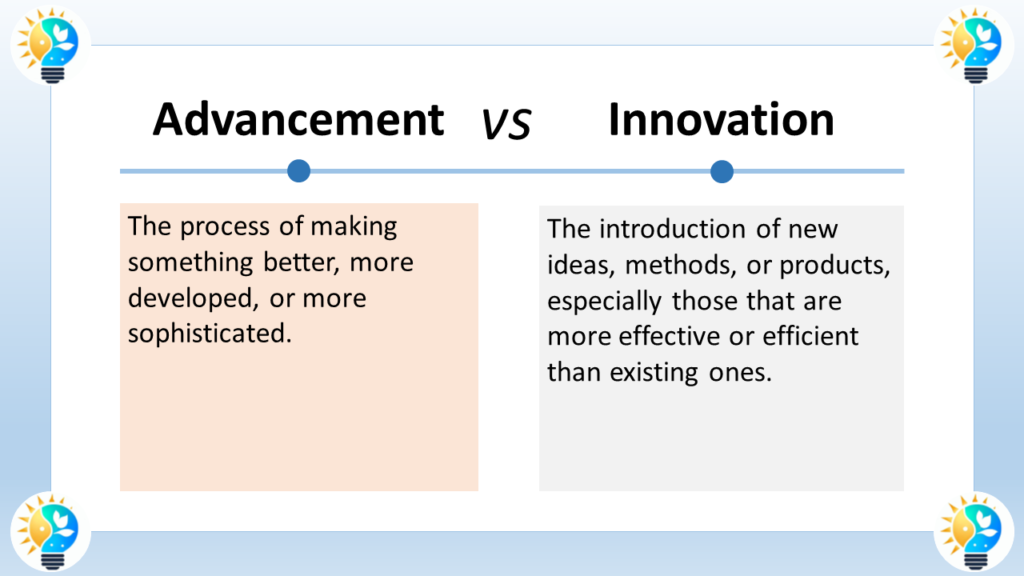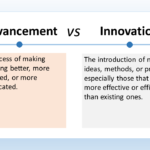
Advancement involves enhancing existing methods or products to a higher level.
Innovation introduces entirely new ideas or methods, often surpassing existing solutions with more effective or efficient approaches.
Innovation and advancement are two concepts that are often closely linked.
Definitions
Innovation refers to the process of creating new ideas, products, or methods. It can also refer to the implementation of these new ideas, products, or methods in a practical context. Innovation can take many forms, including technological innovation, social innovation, and business model innovation.
Advancement: Advancement refers to progress or improvement in a particular field or area. This can refer to progress in scientific knowledge, technological capabilities, social conditions, or other areas of human endeavor. Advancement often involves the application of new ideas, methods, or technologies to solve problems or achieve goals.
More Synonyms on innovation, innovate and innovative
Innovation Terms

Innovation is considered as a driving force in progress.
It includes the introduction of novel ideas, methods, or products that bring positive change and advancement.
For more information about innovations, check our glossary
Differences between innovation and advancement
The differences between innovation and advancement lie in their nature and scope.
Progress refers to the gradual improvement or advancement of something, while innovation involves the introduction of something new and different. Innovation introduces new ideas or ways of doing things, incorporating changes to existing processes, and providing a technical or competitive advantage.
On the other hand, advancement is often associated with gradual improvement and can encompass both innovation and other forms of improvement. In summary, innovation is about introducing new ideas or methods, while advancement is a broader term that includes progress and various forms of improvement.
Innovation is defined as the ways in which an organization updates, changes, and improves its internal processes, manufacturing techniques, and management methods. It can involve both breakthrough and incremental changes, and must meet certain criteria to be successful, including meeting customer needs, satisfying expense and return on investment requirements, improving employee satisfaction, and product quality.
Innovation and Technological Progress
One way to examine the relationship between innovation and advancement is through the lens of technological progress. Throughout history, major technological innovations have often led to significant advancements in fields such as transportation, communication, and medicine. For example, the invention of the steam engine in the 18th century revolutionized transportation and manufacturing, paving the way for the Industrial Revolution and the rapid economic growth that followed. Similarly, the development of the internet in the late 20th century has transformed the way we communicate, access information, and conduct business, leading to advancements in fields such as e-commerce and digital marketing.
Incremental Improvements and Social Factors
However, it is important to note that innovation is not always the sole driver of advancement. In some cases, advancements may be the result of incremental improvements or refinements to existing technologies, rather than entirely new inventions. For example, the development of modern airplanes was not the result of a single breakthrough invention, but rather a gradual process of refining and improving earlier designs. In other cases, advancements may be driven by social, economic, or political factors, rather than purely technological ones. For example, the Civil Rights Movement in the United States led to significant advancements in the areas of racial equality and civil rights, even though it was not directly tied to any particular technological innovation.
Innovation and Economic Growth
Another important aspect of the relationship between innovation and advancement is the role that innovation plays in driving economic growth. Many economists argue that innovation is a key driver of long-term economic growth, as it leads to the creation of new industries, jobs, and wealth. For example, the development of the personal computer in the 1970s and 1980s created an entirely new industry, and helped to spur the growth of the global economy. Similarly, the rise of the smartphone in the early 21st century has created new opportunities for entrepreneurs and businesses, and has contributed to the growth of the digital economy.
However, it is important to note that the relationship between innovation and economic growth is not always straightforward. In some cases, innovation can lead to job displacement or disruption in certain industries, as new technologies replace older ones. For example, the rise of e-commerce has led to the decline of traditional brick-and-mortar retail stores, resulting in job losses in that sector. Additionally, the benefits of innovation are not always evenly distributed, and may disproportionately benefit certain groups or regions over others.
Innovation and Addressing Global Challenges
Finally, it is worth considering the role that innovation plays in addressing some of the world's most pressing challenges. From climate change to global health crises, many of the challenges we face today require innovative solutions in order to be effectively addressed. For example, the development of renewable energy technologies is essential for reducing our reliance on fossil fuels and addressing the challenge of climate change. Similarly, advances in medical technology and biotechnology have the potential to improve health outcomes and save lives around the world.
Conclusion
In conclusion, the relationship between innovation and advancement is complex and multifaceted, and cannot be reduced to a simple cause-and-effect relationship. While innovation can certainly drive advancement in many fields, it is not always the sole driver, and may be influenced by a wide range of social, economic, and political factors. Additionally, the relationship between innovation and economic growth is not always straightforward, and may result in job displacement or unevenly distributed benefits. Nevertheless, it is clear that innovation has the potential to play a critical role in addressing some of the world's most pressing challenges, and that fostering a culture of innovation is essential for continued progress and advancement.
FAQ
Q: Can advancement lead to innovation?
A: Yes, continuous advancements in a field can sometimes culminate in innovative breakthroughs.
Q: Is innovation always more impactful than advancement?
A: Not necessarily. While innovations can have dramatic effects, steady advancements can lead to significant cumulative impacts over time.
Q: How do innovation and advancement contribute to progress?
A: Innovation introduces new solutions and paradigms, while advancement ensures continuous improvement and refinement within existing frameworks.
Q: Can a single development be both an innovation and an advancement?
A: In some cases, yes. A development might be innovative in its approach while also representing a significant advancement in its field.

